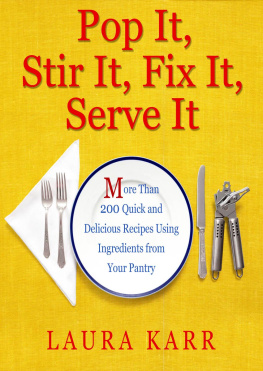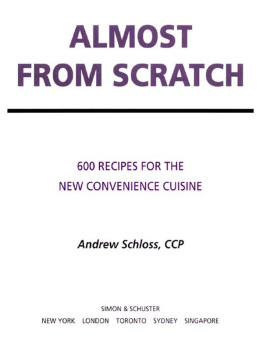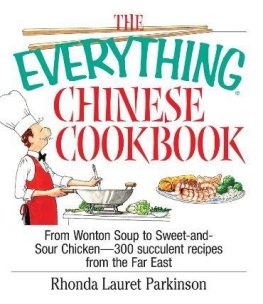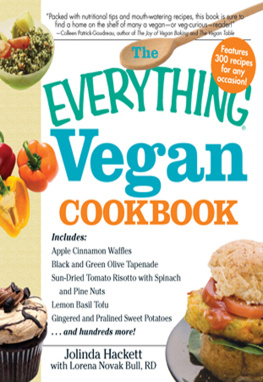Pop It, Stir It, Fix It, Serve It More Than 200 Quick and Delicious Recipes from Your Pantry

For Chris Agnew Introduction

Several years ago I needed to supplement my diet with vitamins and minerals. The catch was, I found that all those pills tasted terrible and were difficult to swallow. I actually caught myself thinking, Man, they can put phones in our cars, so why cant they make chewable vitamins and minerals that taste good? And then I remembered that they didit was called food. Frankly, its a little embarrassing to admit that. I suppose I just felt too busy to eat right all the time, and then when I didnt, it was easy to just give up, as if not eating right once made the whole house of cards collapse. But after the food-vitamin revelation, I promised myself I would do better.
Instead of taking nutritional shortcuts by swallowing a bunch of pills, I would really make the effort to eat nutritious food that contained adequate amounts of vitamins and minerals. I was simply going to have to take my shortcuts elsewhere. In my first book, The Can Opener Gourmet, I told the story of how I came up with the idea for a cookbook that uses canned foods. The above-mentioned nutritional aspect is another piece of that story. And after researching those foods I never used (no one seems to count olives, corn, soup, or tomato sauce as canned food), I decided that they were not only okay to use as shortcuts, they were a valuable source of ready nutrition. I also decided that I didnt have to use them in the way that my mother and her mother did (i.e., casseroles containing canned soup); I could make new combinations using foods we eat more of today.
Since The Can Opener Gourmet was published, there has been a much broader acceptance of kitchen shortcuts that use prepackaged goods. And while I think thats okay sometimes, Im still committed to canned and jarred foods because they are generally free of chemical preservatives. Ive also heard from readers since then who came up with uses for The Can Opener Gourmet that I hadnt thought of, some very gratifying. One woman wrote to say that since she had become disabled she couldnt cook, but with this book, she could. Another told me she tucked the book into all the food baskets her company donated during the holidays. Another mentioned the hurricane weather and snow they had on the East Coast, something I hadnt had to worry about here in California.
And now that baby boomers are hitting the road in RVs in record numbers, it comes in useful there, too. So getting back to this book, in the first chapter Ill review a little about canned foods, their benefits, what more Ive learned about them, and nutrition. If you read the first book and feel comfortable with cans, just plunge into this new batch of recipes. If this is your first foray into the canned-food world, youll probably be shocked at how long canned foods have been around and how nutritionally sound and pure they are. Theres one last thing I feel the need to mention, as I did in the first book. Ive developed these recipes in their simplest format, which means Ive used dried spices.
I also give equivalents and rules of thumb for fresh spices if you have them on hand or prefer to use them. But if youre a little leery about using dried spices, remember that many Indian dishes rely heavily on them, and those are some amazing dishes. So, bon apptit! CHAPTER ONE Whats So Grand About Canned?  A Brief History As Napoleon once said, An army marches on its stomach. Trouble was, pillaging and plundering makes an army hungry, and food only lasted so long and for so many miles back then. So in 1795, Napoleon offered a reward of 12,000 francs to anyone who could find a way to preserve food. (I always wonder how many cases of food poisoning he got and if, in retrospect, he felt the reward was worth it.) It would be another fifty years before Mr. (I always wonder how many cases of food poisoning he got and if, in retrospect, he felt the reward was worth it.) It would be another fifty years before Mr.
A Brief History As Napoleon once said, An army marches on its stomach. Trouble was, pillaging and plundering makes an army hungry, and food only lasted so long and for so many miles back then. So in 1795, Napoleon offered a reward of 12,000 francs to anyone who could find a way to preserve food. (I always wonder how many cases of food poisoning he got and if, in retrospect, he felt the reward was worth it.) It would be another fifty years before Mr. (I always wonder how many cases of food poisoning he got and if, in retrospect, he felt the reward was worth it.) It would be another fifty years before Mr.
Pasteur unraveled the mystery of how heat killed microorganisms responsible for food spoilage. Not to be outdone, a year later the English developed tin-coated iron cans to replace the glass (pillaging and plundering is also hard on breakables). This technology spread to America a few years later, and by the end of the nineteenth century, the first automatic can-making machines were introduced. But food preservation and storage arent the only advantages cans have going for themthey also offer some surprising health and convenience benefits. THEYRE NATURAL FOODS, YET PEST-FREE Canned food is nearly always preservative-free.
Canned food is nearly always preservative-free.  Commercial canning eliminates as much as 99 percent of the pesticide residues occasionally found in fresh produce.
Commercial canning eliminates as much as 99 percent of the pesticide residues occasionally found in fresh produce.  Canning also destroys bacteria that cause food spoilage.
Canning also destroys bacteria that cause food spoilage.  Canning also destroys bacteria that cause food spoilage.
Canning also destroys bacteria that cause food spoilage.
This is accomplished through the normal washing, peeling, blanching, and heat processing of canned fruits and vegetables.  Canned tuna does not carry the risk of histamine poisoning, as does fresh tuna.
Canned tuna does not carry the risk of histamine poisoning, as does fresh tuna.  Baby food, which is used in some of my recipes, is one of the purest foods availableusually consisting of just the fruit or vegetable pureed with a little water. THEY SEAL IN NUTRITION, AND LOTS OF IT
Baby food, which is used in some of my recipes, is one of the purest foods availableusually consisting of just the fruit or vegetable pureed with a little water. THEY SEAL IN NUTRITION, AND LOTS OF IT Because fruits and vegetables are generally harvested at their peak and then quickly heat-sterilized and sealed, canned items do not lose their nutritional potency in the same way as many fresh foods that sit in warehouses, then in trucks, and then on grocery shelves.
Because fruits and vegetables are generally harvested at their peak and then quickly heat-sterilized and sealed, canned items do not lose their nutritional potency in the same way as many fresh foods that sit in warehouses, then in trucks, and then on grocery shelves.  Canned foods are preserved in their own juices, which contain much nutritional value that is often lost with many home-cooking methods.
Canned foods are preserved in their own juices, which contain much nutritional value that is often lost with many home-cooking methods.  Although the body needs some salt to function normally, many canned foods offer no- or low-sodium alternatives for those wishing to curb salt intake.
Although the body needs some salt to function normally, many canned foods offer no- or low-sodium alternatives for those wishing to curb salt intake.  Rinsing canned foods in a colander under cold water can reduce sodium content up to 40 percent.
Rinsing canned foods in a colander under cold water can reduce sodium content up to 40 percent.  Tomatoes contain important antioxidants such as lycopene.
Tomatoes contain important antioxidants such as lycopene.  Tomatoes contain important antioxidants such as lycopene.
Tomatoes contain important antioxidants such as lycopene.
Lycopene is a pigment that gives fruits and vegetables their red color, and has been credited with helping to prevent cancer and other diseases. The American Dietetic Association (ADA) cites research that says more lycopene is absorbed from cooked tomatoes than from raw. As a result, canned tomato products (like diced tomatoes, tomato sauce, or tomato puree) are among the best sources of dietary lycopene. 


















 For Chris Agnew Introduction
For Chris Agnew Introduction  Several years ago I needed to supplement my diet with vitamins and minerals. The catch was, I found that all those pills tasted terrible and were difficult to swallow. I actually caught myself thinking, Man, they can put phones in our cars, so why cant they make chewable vitamins and minerals that taste good? And then I remembered that they didit was called food. Frankly, its a little embarrassing to admit that. I suppose I just felt too busy to eat right all the time, and then when I didnt, it was easy to just give up, as if not eating right once made the whole house of cards collapse. But after the food-vitamin revelation, I promised myself I would do better.
Several years ago I needed to supplement my diet with vitamins and minerals. The catch was, I found that all those pills tasted terrible and were difficult to swallow. I actually caught myself thinking, Man, they can put phones in our cars, so why cant they make chewable vitamins and minerals that taste good? And then I remembered that they didit was called food. Frankly, its a little embarrassing to admit that. I suppose I just felt too busy to eat right all the time, and then when I didnt, it was easy to just give up, as if not eating right once made the whole house of cards collapse. But after the food-vitamin revelation, I promised myself I would do better.  A Brief History As Napoleon once said, An army marches on its stomach. Trouble was, pillaging and plundering makes an army hungry, and food only lasted so long and for so many miles back then. So in 1795, Napoleon offered a reward of 12,000 francs to anyone who could find a way to preserve food. (I always wonder how many cases of food poisoning he got and if, in retrospect, he felt the reward was worth it.) It would be another fifty years before Mr. (I always wonder how many cases of food poisoning he got and if, in retrospect, he felt the reward was worth it.) It would be another fifty years before Mr.
A Brief History As Napoleon once said, An army marches on its stomach. Trouble was, pillaging and plundering makes an army hungry, and food only lasted so long and for so many miles back then. So in 1795, Napoleon offered a reward of 12,000 francs to anyone who could find a way to preserve food. (I always wonder how many cases of food poisoning he got and if, in retrospect, he felt the reward was worth it.) It would be another fifty years before Mr. (I always wonder how many cases of food poisoning he got and if, in retrospect, he felt the reward was worth it.) It would be another fifty years before Mr. Canned food is nearly always preservative-free.
Canned food is nearly always preservative-free.